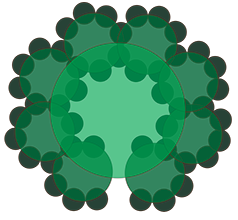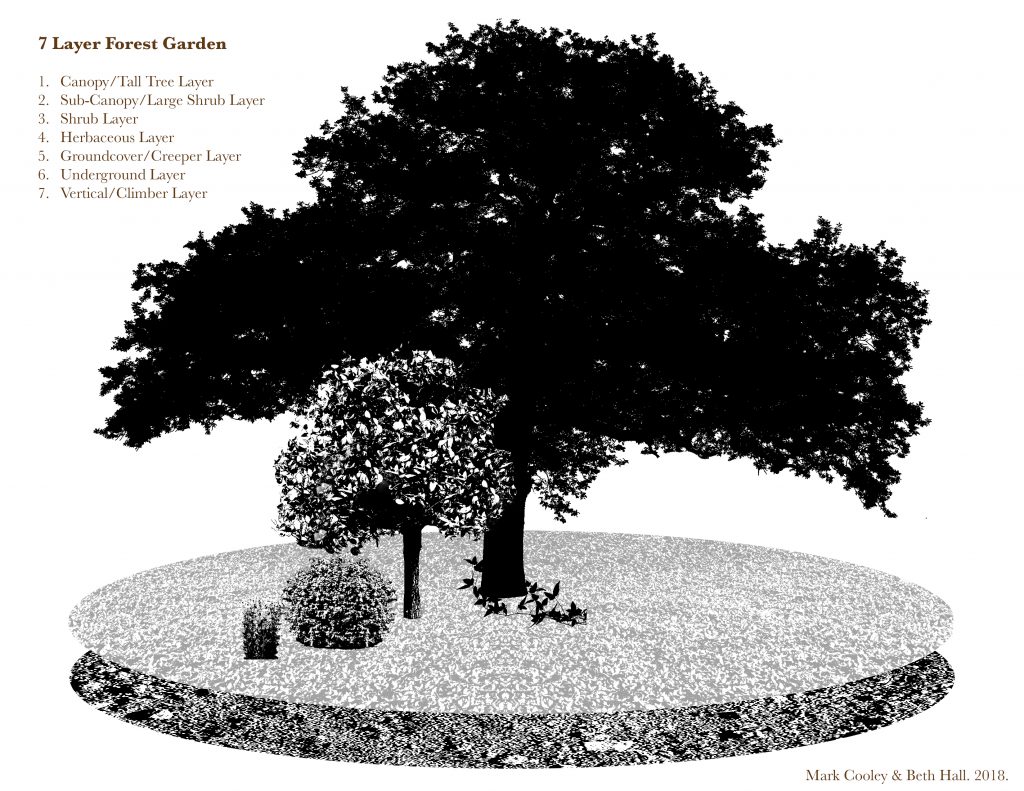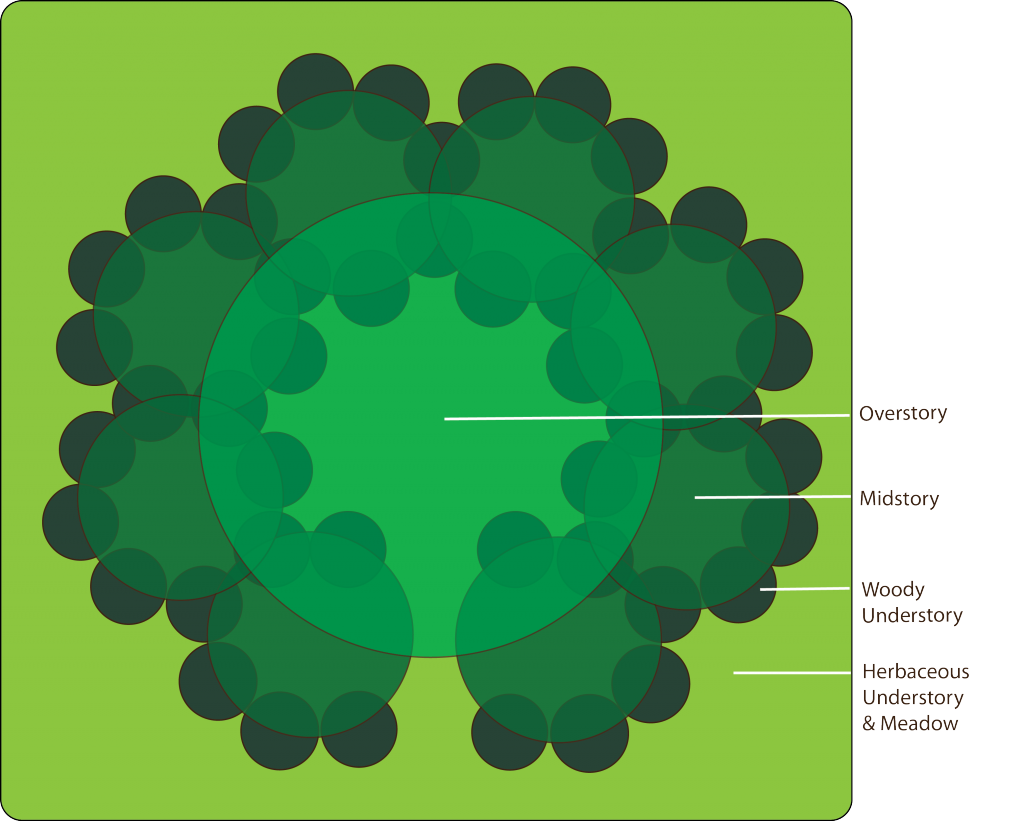Proposal: Darmstadt Food Forest

Proposal for The 9. International Forest Art Path – “Art Ecology”
and the 7. International Forest Art Conference in Darmstadt
The 9. Internationaler Darmstädter Waldkunstpfad organised by
The International Forest Art Association (IFAA) – Verein für Internationale Waldkunst e.V.,
Darmstadt, Germany
Curator: Ute Ritschel, Guest Curator: Sue Spaid
President: Christiane Dette, Vice President: Peter Schüler
Curator: Ute Ritschel, Guest Curator: Sue Spaid
President: Christiane Dette, Vice President: Peter Schüler
Food Forest Guild
“Forest garden” is a forced juxtaposition of binary concepts – “nature” and “culture” and eschews the “man versus nature” paradigm by connecting the wellbeing of humans to the wellbeing of ecosystems that sustain us. Forest gardens combine the human use-value of a “garden” with the self-sustaining ecological function of the “forest” and in doing so provides a new way to realize human potential to work with rather than against nature’s cycles. We propose the design and installation of one or more forest gardens along the forest art path. The gardens – or plant “guilds” – will use a permaculture-based forest garden design concept (see fig. 1, fig. 2), which includes plant “polycultures” occupying cooperative niches in a layered forest habitat. The design focuses on maximizing symbiotic relationships among guild organisms and stacking ecological plant functions (such as nitrogen fixing, dynamic accumulation, erosion control, wildlife food and habitat) as well as offering food and medicine to people. The guild concept invites a realization that human wellbeing is contingent upon environmental wellbeing and invites direct participation in the landscape in ways that are mutually beneficial.


Guild Example: Pawpaw Guild*
Name: Bush Cherry (Prunus spp.)
Type: Perennial Shrub
Ecological Function: Wildlife food, Biomass, Organic Matter
Human Use-value: Food, Medicine
Name: Bush Apricot (Prunus spp.)
Type: Perennial Shrub
Ecological Function: Wildlife food
Human Use-value: Food, Medicine
Name: Elderberry (Sambucus nigra)
Type: Perennial Shrub
Ecological Function: Wildlife Food, Biomass, Organic Matter
Human Use-value: Food, Medicine
Name: Persimmon (Diospyros virgininiana)
Type: Perennial Tree
Ecological Function: Wildlife Food, Biomass, Organic Matter
Human Use-value: Food, Medicine, Wood
Name: Pawpaw (Asiminia triloba)
Type: Perennial Tree
Ecological Function: Edges, Open woods, Biomass, Organic Matter, Wildlife Food
Human Use-value: Food, Medicine
Name: Yarrow (Achillea millifolium)
Type: Perennial
Ecological Function: Dynamic Accumulator, Insectary, Nectary, Ground Cover
Human Use-value: Medicine
Name: Comfrey (Symphytum officinale)
Type: Perennial
Ecological Function: Domestic Animal Forage, Chemical Barrier, Insecticide, Insectary, Mulch Maker, Dynamic Accumulator, Water
Human Use-value: Medicine, Food
Name: Red Clover (Trifolium spp.)
Type: Perennial
Ecological Function: Nitrogen Fixer, Dynamic Accumulator, Nectary, Ground Cover, Cover Crop, Insectary
Human Use-value: Food, Medicine, Forage
Name: Wild Ginger (Asarum caudatum)
Type: Perennial
Ecological Function: Soil Builder, Erosion Control
Human Use-value: Food, Medicine
Name: Tulip (Tulipa gesneriana)
Type: Perennial
Ecological Function: Early Spring insectary
Human Use-value: Early-Spring Pollinator and Beneficial Insect Attractor
Name: Anise Hyssop (Agastache foeniculum)
Type: Perennial
Ecological Function: Invertebrate Shelter, Insectary
Human Use-value: Medicine, Tea, Spice
Name: Dandelion (Taraxacum officinale)
Type: Perennial
Ecological Function: Dynamic Accumulator, Insectary
Human Use-value: Medicine
Name: Feverfew (Tanacetum parthenium)
Type: Perennial
Ecological Function: Dynamic Accumulator, Biomass
Human Use-value: Medicine
Name: Oregano (Origanum spp.)
Type: Perennial
Ecological Function: Nectary, Insectary, Ground Cover (erosion control)
Human Use-value: Tea, Spice, Medicine
Name: Yucca (Yucca filamentosa)
Type: Perennial
Ecological Function: Wildlife food, Wildlife Shelter
Human Use-value: Food, Soap, Fiber, Medicine, Basketry
Name: Rosemary (Rosmarinus officinalis)
Type: Perennial
Ecological Function: Wildlife Food, Nectary, Insectary
Human Use-value: Medicine, Spice, Tea, Incense, Essential Oil
Name: Horseradish (Armoracia rusticana)
Type: Perennial
Ecological Function: Biomass, Organic Matter, Dynamic Accumulator
Human Use-value: Food, Medicine
*Example Guild from, “Integrated Forest Gardening: The Complete Guide to Polycultures and Plant Guilds in Permaculture Systems” by Wayne Weisman, Daniel Halsey, and Bryce Ruddock. We also consulted with Wayne Weisman in developing this project proposal.
Note: Above is just one example of out of a great number of possible guilds, and there are a great number of plants, which offer both ecological and human uses, suitable for a forest habitat in Darmstadt’s climate. We also have guild designs that work under both various common species including Pine, Oak, Maple, etc.